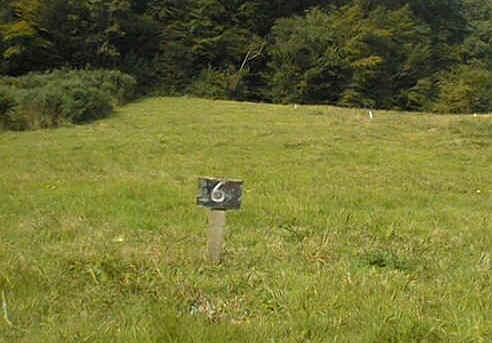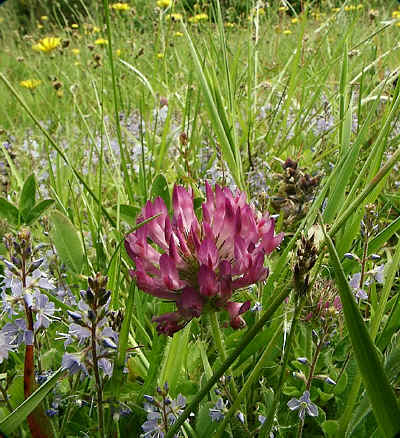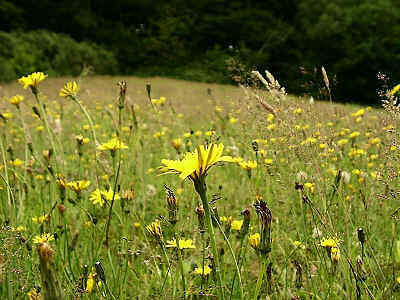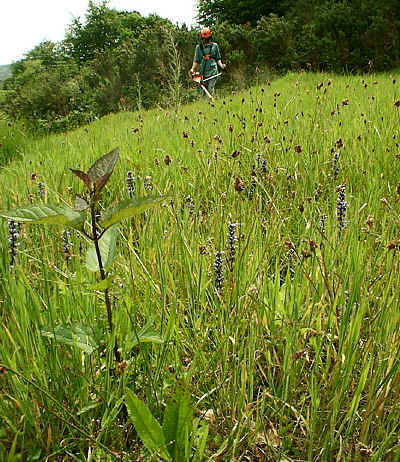|
The Woodland Education Centre |
|
|
The Woodland Education Centre |
|
Ecological Survey 1999
Spring, Summer & Autumn Cut
(Section 6)
 |
This section contained the most plant species of any of the sections and although it was dominated by the grasses, Yorkshire Fog and Common Bent, these were intermingled with a great variety of wild flowers and mosses at ground level. |
 |
The section
was very diverse over much of its area and each quadrat normally contained a considerable
number of different species. Included amongst the wildflowers were Greater Bird's-foot Trefoil, as well as several species more characteristic of heathland habitats, such as Heath Speedwell (light blue flower spikes on the left) and Tormentil. |
 |
The composite
flowering plant family was well represented in this section, with several perennial and
biennial species commonly found across much of the area. These included Cat's-ear (yellow flowers on the left), Autumn Hawkbit, Marsh Thistle and some Ragwort. These grew interspersed among the dominant grasses. |
 |
The section also contained considerable quantities of the creeping herb, Bugle (blue flower spikes on the left) together with Woodrushes (also visible flowering on the left). These plants flower in the spring and have died back considerably by the time of the annual survey in July. As a result, their dominance is not truly reflected in the survey data. This section contained fewer tree seedlings than other sections, although a non-native cherry seedling is visible in the foreground (left) |
| Heather,
although not widespread, occurred in several large, extremely dense clumps. A few isolated
plants of Bell Heather were also present. There was little Bramble or Silver Birch in this section. |
Dominant Plants in
Section 6 in 1999
with figures from 1998 for comparison.
Characteristic heath species are in bold print
| Species | Overall % frequency | Mean % Cover (all quadrats) | ||
| 1999 | 1998 | 1999 | 1998 | |
| Yorkshire Fog | 96 | 100 | 25 | 42 |
| Common Bent | 96 | 88 | 30 | 22 |
| Common Dog-violet | 92 | 50 | 15 | 4 |
| Heath Speedwell | 63 | 33 | 13 | 5 |
| European Gorse | 54 | 29 | 16 | 4 |
| Slender St John's-wort | 50 | 63 | 4 | 4 |
| Pill Sedge | 42 | 4 | 5 | 0.5 |
| Greater Bird's-foot Trefoil | 42 | 42 | 3 | 14 |
| Smooth-stalked Sedge | 38 | 33 | 9 | 5 |
| Bugle | 38 | 21 | 4 | 2 |
| Marsh Thistle | 33 | 21 | 11 | 2 |
| Eurhynchium praelongum | 33 | 4 | 7 | 0.5 |
| Polytrichum formosum | 29 | 42 | 18 | 18 |
| Heath Woodrush | 29 | 4 | 2 | 0.5 |
| Green-ribbed Sedge | 25 | 8 | 5 | 1 |
| Compact Rush | 25 | 29 | 4 | 2 |
| Thuidium tamarascinum | 25 | 8 | 4 | 0.5 |
| Heather | 21 | 8 | 6 | 3 |
| Cat's-ear | 21 | 17 | 4 | 5 |
| Percentage frequency = the percentage of the total number of quadrats sampled over the whole site which contain the species. For example, a percentage frequency of 100%, means that the species was found in all quadrats sampled. |
Summary:
Changes since the previous year:
|
>> Continue to Handweeded Section Description
Ecological Survey 1999 |